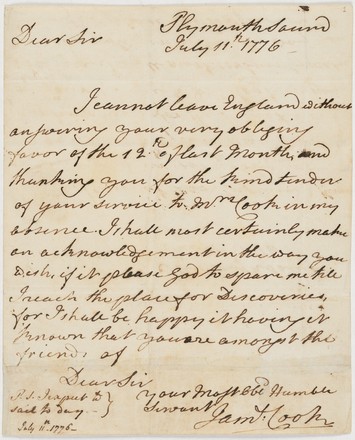Letter from James Cook to Rev Dr Richard Kaye
1776
Manuscript
Bequest of Sir William Dixson, 1952
DLMS 92
The clergyman and scientist Richard Kaye became rector of the parish of Kirkby in northwest England in 1765, and was still serving in that position in 1776 when James Cook departed on his third voyage of discovery. Considered a man of great character, intellect, faith and compassion, Kaye became a friend of James Cook and a much-appreciated support to Cook’s wife Elizabeth during Cook’s long absences.
Honouring a promise made in this letter to acknowledge Kaye’s service, Cook named the island now known as Kayak Island in the Gulf of Alaska after him. Visiting there on 12 May 1778, Cook buried a bottle with a paper and two small pieces of silver given to him by Kaye.
Kaye seemed to be popular in his parish, and many families who were Methodists and Anabaptists came back to the church at this time. Between 1765 and 1774 he noted that the number of ‘Dissenters’ had dropped from 78 to 24, and the number of children in school had risen from 21 to 109.
Cook’s third and final voyage of discovery was an attempt to locate the North-West Passage, an ice-free sea route which linked the Atlantic to the Pacific. It was on this voyage that Cook visited Hawaii, becoming the first European to land there. He was very impressed with the hospitality of the island people. But stopping there a second time, relations soured. In the hostilities that erupted, Cook was killed, along with four of his marines and 17 Hawaiians.
Richard Kaye was elected a Fellow of the Royal Society in 1765 as an experimentalist in the field of electricity. Kaye proposed the botanist Joseph Banks for membership of the Royal Society.
Cook’s Cottage stands in the grounds of Fitzroy Gardens in Melbourne. It was purchased by prominent Melbournian Russell Grimwade in 1933, dismantled, and shipped to Melbourne in 253 packing cases, arriving April, 1934. The rebuilt cottage was handed over to the lord mayor on 15 October 1934 as part of Victoria’s centenary celebrations.
Some of the State Library’s most important treasures relate to Captain James Cook and his Pacific voyages of discovery. Many of these items were purchased by the NSW government in the late 19th century from descendants of Cook’s wife, Elizabeth, following a display about Cook at the Colonial and Indian Exhibition in London in 1886. Under the negotiations of the NSW agent-general in London at the time, Sir Saul Samuel, many of the exhibition items were purchased and sent to Sydney, where they were housed in the Australian Museum. They were transferred to the Library in October 1935.
Navigator and explorer James Cook circumnavigated New Zealand and charted its coast in 1770 before discovering and charting the east coast of Australia. On his second major voyage between 1772 and 1775, he circumnavigated the world in the Resolution, exploring New Zealand, the Pacific and Antarctica before returning to England. On his third voyage he visited New Zealand and Tahiti and explored the Pacific coasts of North America and Siberia. He was killed on 14 February 1779 in the Sandwich Islands (Hawaii).
Cook was given command of the Endeavour in 1768 and set sail from Plymouth in August of that year on Britain's first great voyage of ocean exploration. The expedition was mounted by the Admiralty and the Royal Society. The main aim was to chart and explore the Pacific Ocean and to observe and record the Transit of Venus across the sun in April 1769 from Tahiti.
In May 1776, only weeks before this letter was written, Kaye’s parish of Kirkby was suffered an outbreak of small pox, brought from a colliery village in Derbyshire. Kaye offered every family – regardless of sect – the chance of innoculation at his expense.
After completing the circumnavigation of New Zealand in 1769, Cook decided 'to steer to the Westward until we fall in with the E coast of New Holland'.* At 6 pm on 19 April 1770, Lieutenant Hicks saw land, and a point at the southeast of the Australian mainland was named after him.
Footnotes
* Journal of HMS Endeavour, 1768–71, 31 March 1770, (NLA MS 1)



 Back to list
Back to list